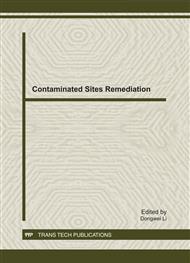p.121
p.126
p.132
p.139
p.144
p.150
p.156
p.161
p.166
Effect of Applied Voltage on the Electrokinetic Removal of Chromium from Soils
Abstract:
Electrokinetic remediation, variably named as electrochemical soil processing, electromigration, ectrokinetic decontamination or electroreclamation, uses electric currents to extract radionuclides, heavy metals, certain organic compounds, or mixed inorganic species and some organic wastes from soils and slurries. This paper presents the experimental study on the effect of applied voltage on the electrokinetic removal of the chromium from kaolin at laboratory scale. Potassium dichromate was chosen as the pollutant and its initial concentration was 100 mg·kg-1 and 500mg·kg-1, the moisture content of samples is 50%. The experiments were operated 48 hours and the pH of cathode was control at 4-7 with of acetic acid. And a series of voltages were applied. The results indicate the removal efficiencies increase with the increase of applies voltage, when the voltage is 1V/cm, the efficiencies increase significantly, the efficiency reach up to 76.7% and 89.8% of two studied samples. The electric energy consumptions also increase significantly due to the increase of applied voltage. The experiment data show 1-1.5V/cm is cost effective voltage range for the soils studied.
Info:
Periodical:
Pages:
144-149
Citation:
Online since:
December 2011
Authors:
Keywords:
Price:
Сopyright:
© 2012 Trans Tech Publications Ltd. All Rights Reserved
Share:
Citation:


